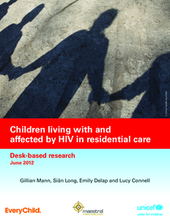Background
Evidence suggests that the phenomenon of residential care has been growing in recent years due to a complex interplay of different factors, among them HIV and AIDS. To date, there is no systematic information on the numbers of children living with or directly affected by HIV who are placed in residential care, the reasons for and the impacts of their placement on individual children, their families and communities and on the residential care facilities themselves.
Need for Data
This paucity of data makes it difficult to monitor the success of efforts to support family-based care, prevent separation and promote reunification for all children, including those affected by HIV. It also impairs efforts to ensure that children living with HIV in residential care are able to access HIV-specific services that are supportive and appropriate. In this context, tracking the extent to which the HIV pandemic has been a driver of growth in children’s residential care is very difficult.
Desk-review Process
In recognition of the need to know more about these issues, UNICEF commissioned EveryChild and Maestral International to provide technical assistance and evidence collection in relation to the care of children living with HIV in residential care. Through a combination of desk-based research and in-country data collection, the focus of this exercise is primarily on the extent, quality, impacts and responses to residential care for boys and girls (0-18 years) living with or directly affected by HIV. This report provides information from the desk-based component of this study, which is based on an extensive review of published and grey literature, and information gathered from experts working in this field.
Summary of Key Findings
- Despite the attempts of governments worldwide to limit the use of residential care, particularly large-scale dormitory-style facilities, the numbers of such facilities have been increasing over the past several years.
- Insufficient attention has been paid to developing options for alternative care, especially, but not exclusively, for HIV-affected children.
- Children living with HIV appear to have restricted and poorer care choices compared to able-bodied, (assumed to be) HIV-negative children. Not only are they are more vulnerable to losing their parents at an early age, but high levels of stigma, discrimination and misconceptions about the transmission of the virus mean that in some cases they may be denied kinship care and access to foster care, adoption and some residential facilities.
- Children living with HIV have very specific medical needs related to access to treatment, effective monitoring and support. Medical services are essential to their survival and wellbeing. It is unclear whether residential care facilities are able to provide these types of services to children, and whether boys and girls living with HIV in residential care have fewer opportunities to access HIV services than they would in a family-based setting.
- Children living with and affected by HIV face particular risks to their emotional and social wellbeing. Currently, these needs appear to be inadequately supported in residential care, a finding largely evidenced by the fact that there is so little data on children’s HIV status or family HIV-related situation.
- Quality care is compromised in many residential care facilities due to inadequate infrastructure, limited financial resources, lack of appropriate training and supervision of care personnel. There is also limited awareness of child development in general, and the specific needs of children living with HIV in particular. All children need quality care, but children living with HIV and have direct experience of HIV in the family can often experience negative and long-lasting psychological impacts. HIV infection itself and the poverty caused by HIV in the household can in many cases lead to increased vulnerability to a whole series of risks, including, but not limited to, stunting, illness and delays in a child’s cognitive and physical development.

